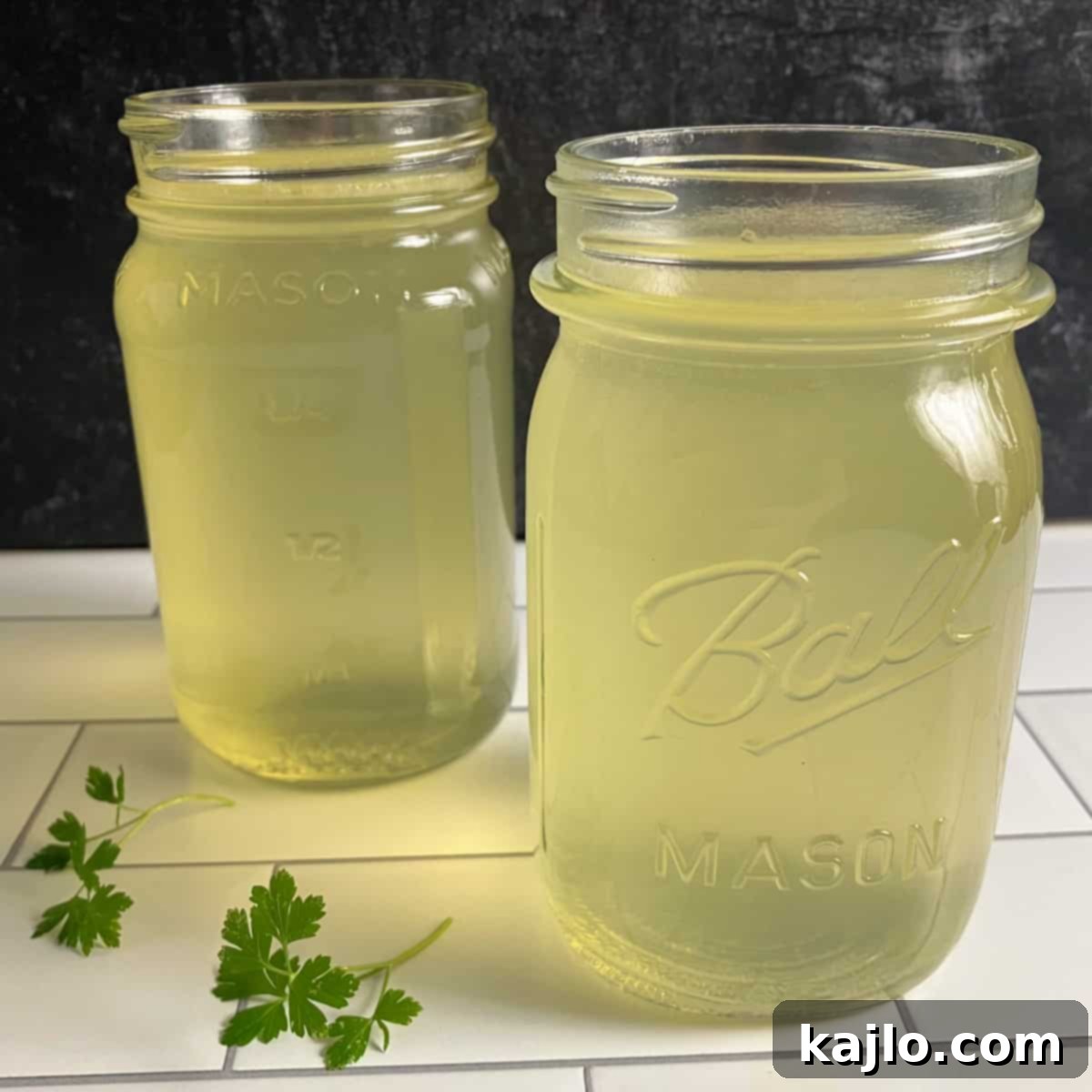Master Chicken Backs: Delicious Recipes for Nourishing Stock and Hearty Soup
Unlock the potential of an often-overlooked cut of poultry: chicken backs! This comprehensive guide will show you how to transform humble chicken backs into two incredible, family-friendly dishes. First, you’ll learn to make a rich, flavorful chicken back stock – a nutrient-dense bone broth that is naturally low carb, keto, and gluten-free. Then, we’ll elevate this foundational stock into a comforting and wholesome chicken back soup, packed with fresh vegetables and aromatic herbs. Beyond the recipes, discover valuable insights on where to buy chicken backs, their nutritional benefits, practical cooking tips, and much more. Get ready to cook smarter, save money, and enjoy incredibly flavorful meals!
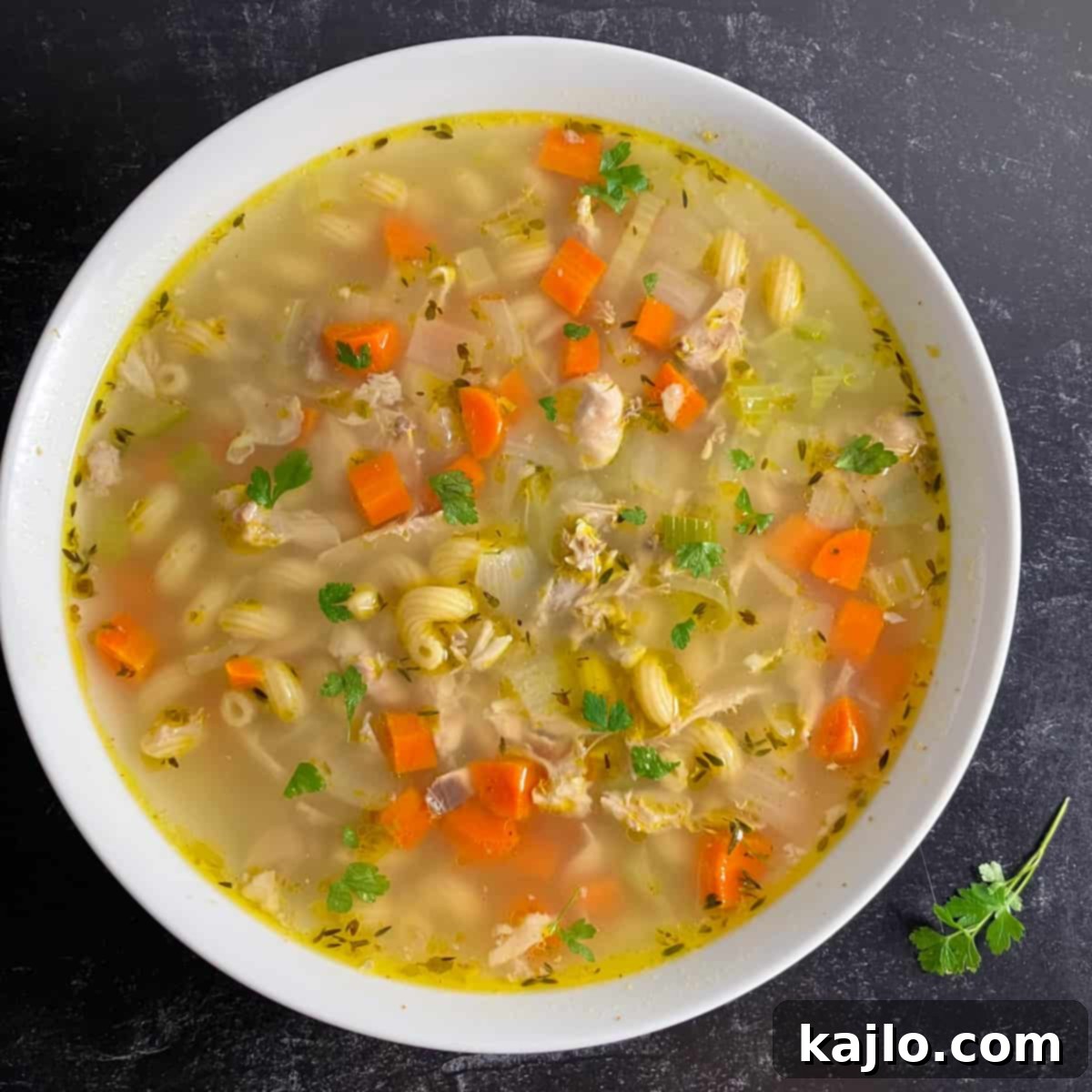
Understanding Chicken Backs: The Underrated Cut
The chicken back is precisely what its name implies: the rear portion of the chicken. It primarily consists of the chicken backbone and any meat, skin, and connective tissues that remain after the more popular cuts like breasts, wings, and legs have been removed. Often considered a secondary cut, chicken backs are a hidden gem for budget-conscious cooks and those seeking to maximize flavor and nutrition from their poultry.
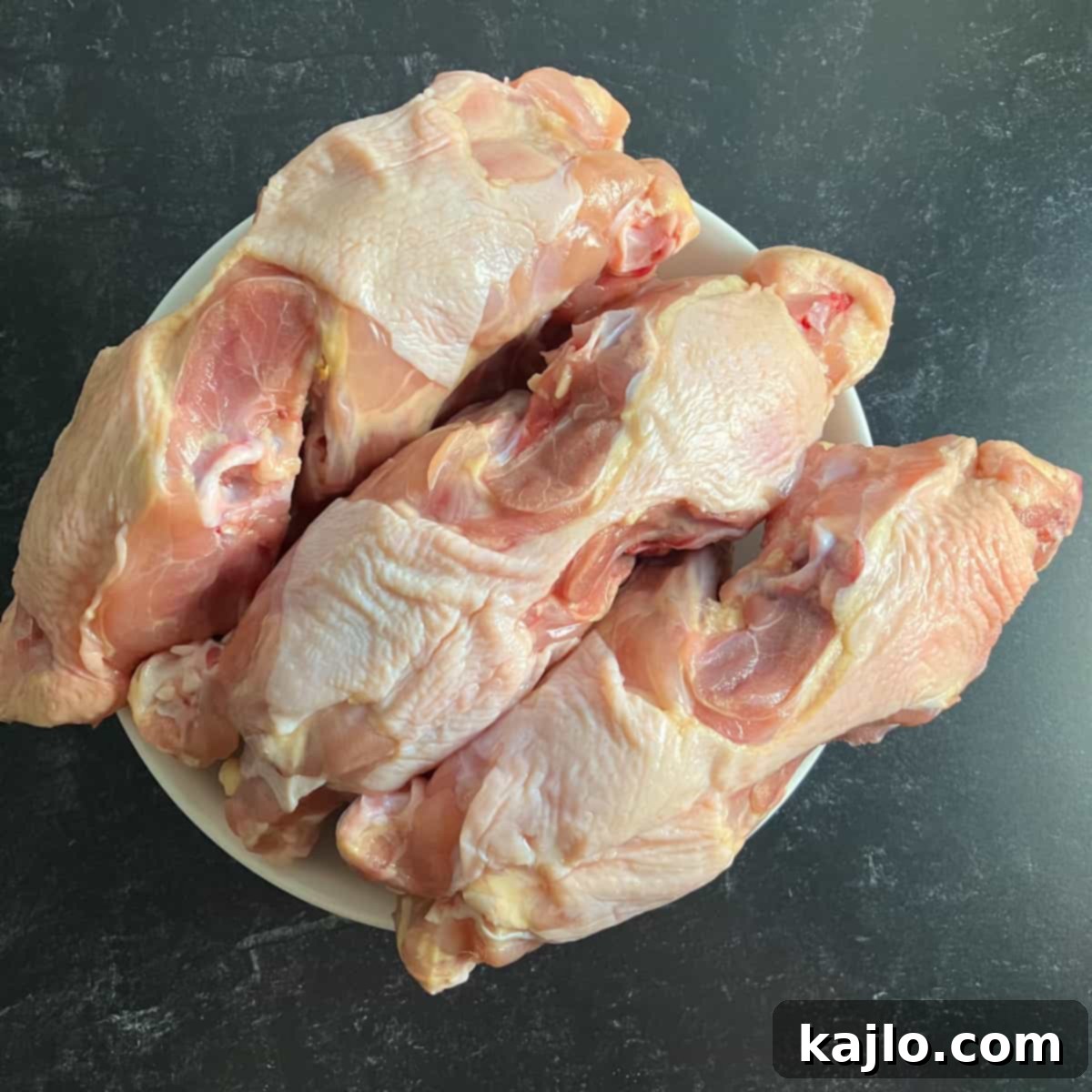
Sourcing Your Chicken Backs: Where to Find This Value Cut
Finding chicken backs for sale can sometimes require a bit of searching, as they aren’t always prominently displayed in conventional grocery stores. In the United States, your best bet might be local farmer’s markets or directly from farms specializing in poultry. These sources often sell whole chickens or parts, including the backs, offering fresher, often pasture-raised options. Many online purveyors also offer quality chicken backs. For instance, US Wellness Meats provides pasture-raised chicken backs, which you can typically find here.
While you might not find them at major chain supermarkets like Whole Foods, it’s always worth asking your local butcher. A crucial tip: double-check that the chicken backs you purchase are intended for human consumption, as some retailers also sell them as pet food. US Wellness, for example, offers separate chicken backs for dogs, so be mindful of your selection.
The Culinary Potential of Chicken Backs: More Than Just Bones
Don’t let the “backbone” title mislead you; chicken backs offer surprising culinary versatility, especially when you understand how to best utilize them. They are a cost-effective and flavorful foundation for a variety of dishes.
White Meat or Dark Meat?
Many wonder, “Are chicken backs white meat?” The meat found on chicken backs is generally considered white meat. This is because it’s primarily composed of the muscle left over after the chicken breast has been removed. While the quantity of meat can vary, it typically has a texture and flavor profile similar to breast meat, making it a lean protein source.
Why Chicken Backs Are Ideal for Cooking
Chicken backs possess a high bone-to-meat ratio. This means they are largely bone, with a moderate amount of meat, skin, and connective tissue attached. This characteristic makes them uniquely suited for certain cooking applications. While some chicken backs might be meatier than others depending on the processing, the abundance of bones, cartilage, and marrow is precisely why they shine in recipes that extract their rich essence.
For this reason, the best chicken backbone recipes leverage both the meat and the bones. Making nourishing soups, stews, or, most notably, a deeply flavorful stock, are superior ways to utilize this economical cut of poultry. These methods allow the bones to release their collagen and minerals, creating a robust base, while the meat tenderizes to add substance and protein to your dish.
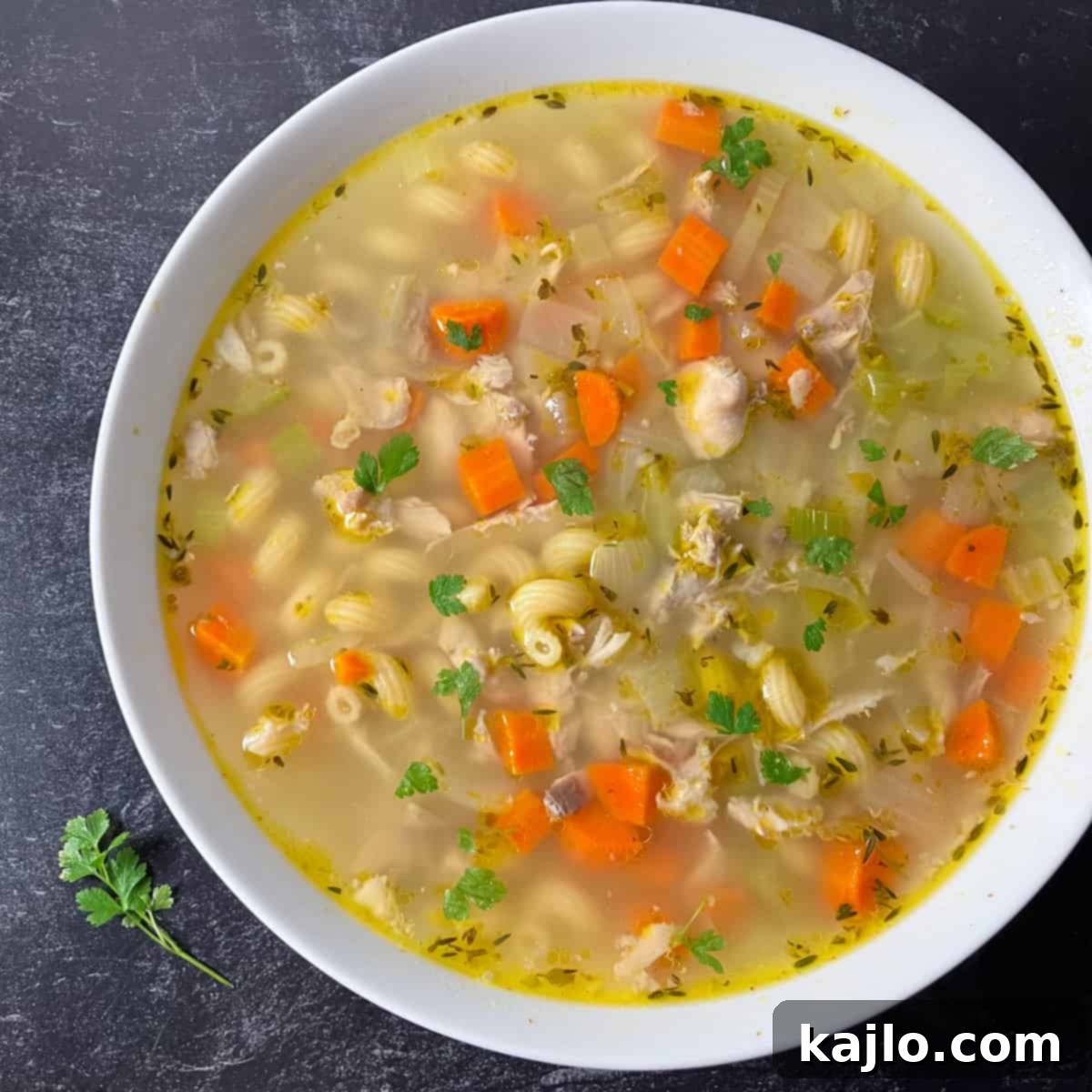
The Foundation: Crafting Exceptional Chicken Back Stock
Yes, chicken backs are absolutely excellent for stock! In fact, many culinary enthusiasts consider them a secret ingredient for homemade bone broth. When simmered gently for hours, the bones, cartilage, and residual meat release a wealth of nutrients, including collagen, amino acids, and minerals, resulting in a gelatinous, full-bodied broth that is far superior to anything store-bought. You not only extract a rich, deeply flavored base, but you also yield a small amount of tender cooked meat that can be incorporated into your soup or other dishes. Making your own chicken back stock is arguably the most efficient and flavorful way to utilize this cut.
The Secret to the Best Bone Broth
While chicken backs provide a wonderful base for bone broth, some might argue that chicken feet produce an even more gelatinous and collagen-rich broth. For example, my chicken feet soup is a testament to their richness. However, chicken feet offer little to no meat. For the ultimate balance of richness and substance, consider using a mix of chicken feet and chicken backs. This combination gives you the intense collagen boost from the feet and the flavorful meat from the backs, creating a truly exceptional bone broth.
Step-by-Step: How to Make Rich Chicken Back Broth
Making homemade chicken back stock is surprisingly simple and incredibly rewarding. The process requires minimal effort but yields maximum flavor and nutrition. Chicken backs are often sold frozen, so ensure they are fully thawed in the refrigerator for 24-48 hours before you begin. For this recipe, we’ll use approximately 2.75 lbs. (1.25 kg) of thawed chicken backs. Follow these easy steps to create your nourishing broth:
- Prepare the Initial Simmer: Carefully place the thawed chicken backs into a large, sturdy pot or Dutch oven. Add 1 tablespoon of apple cider vinegar and 12 cups of cold water. Ensure the chicken backs are completely submerged in water. If they aren’t, add more water until they are adequately covered. The apple cider vinegar helps to draw minerals and collagen from the bones, enriching your broth.
- Gentle Simmering: Bring the pot to a gentle simmer over low to medium-low heat on your stovetop. Maintain a very low, consistent simmer for 2-3 hours. As the broth cooks, you might notice “scum” (impurities) rising to the surface. Use a spoon or ladle to skim this off periodically for a cleaner broth. To prevent excessive water evaporation, partially cover the pot, and reduce the heat further if necessary.
- Strain the Broth: After simmering, carefully strain the hot broth through a colander into another large bowl or pot. For a beautifully clear broth, as seen in professional kitchens, line your colander with cheesecloth before straining. The cheesecloth effectively catches any smaller particles or sediment that could make the stock cloudy.
- Harvest the Meat: Once the chicken backs have cooled enough to handle, carefully remove any usable chicken back meat from the skin and bones. This meat will be incredibly tender. Chop it into bite-sized pieces and refrigerate it to be used in the soup recipe below or for other culinary purposes. From 2.75 lbs of chicken backs, you might yield about 2 cups of cooked meat.
- Optional Extended Simmer for More Nutrients: If you wish to extract even more minerals and collagen, you can return the strained bones (without the meat, as it can become too tough if cooked much longer) to the pot with the broth and continue to simmer for an additional 18-24 hours. This extended cooking time maximizes the nutritional benefits of your bone broth.
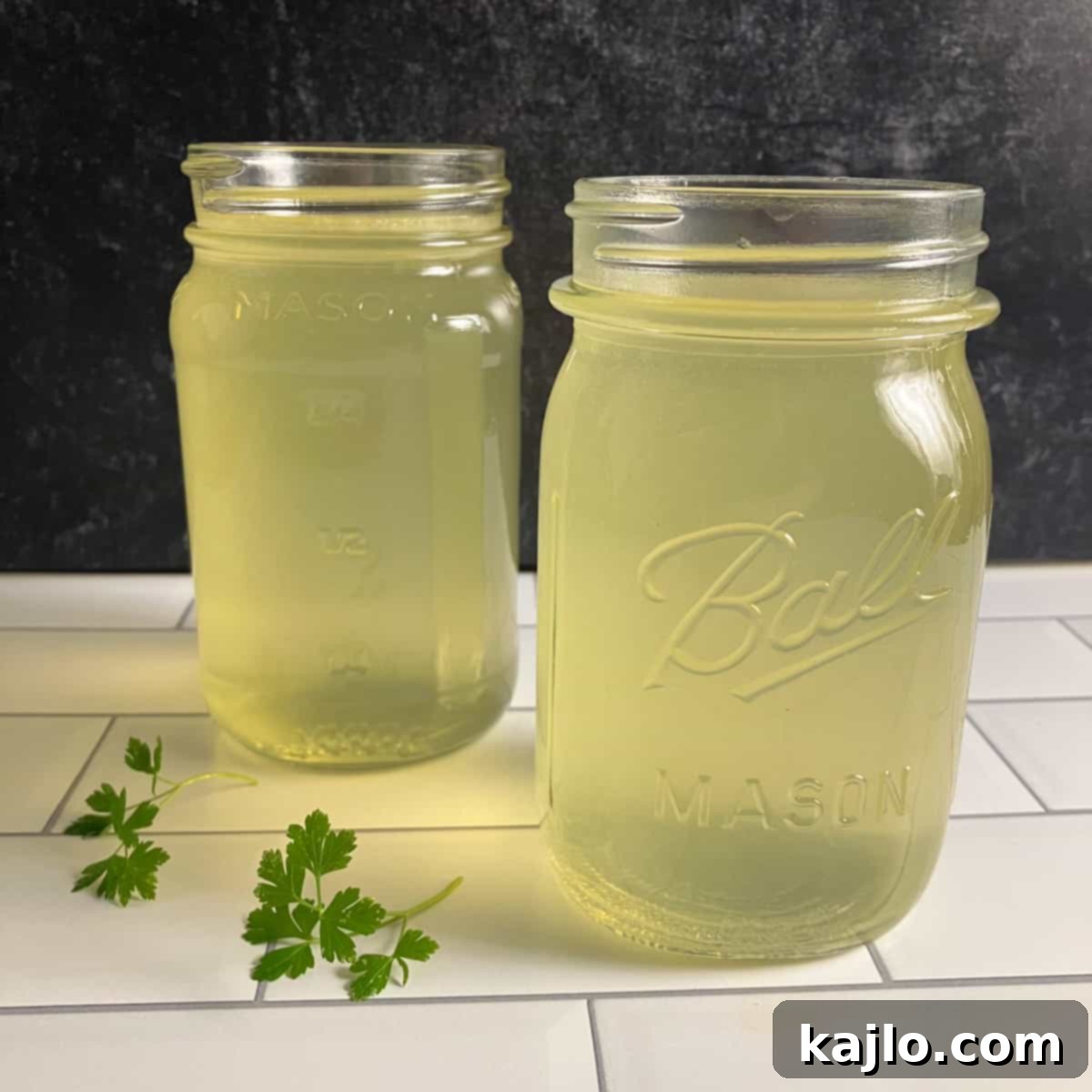
Remember that you’ll need approximately 7 cups of broth to prepare the chicken back soup, so monitor your water levels during simmering. No need for a meat thermometer here, as the long simmering process ensures the chicken is thoroughly cooked and safe for consumption.
🥣 Transforming Stock into a Hearty Meal: Chicken Back Soup Recipe
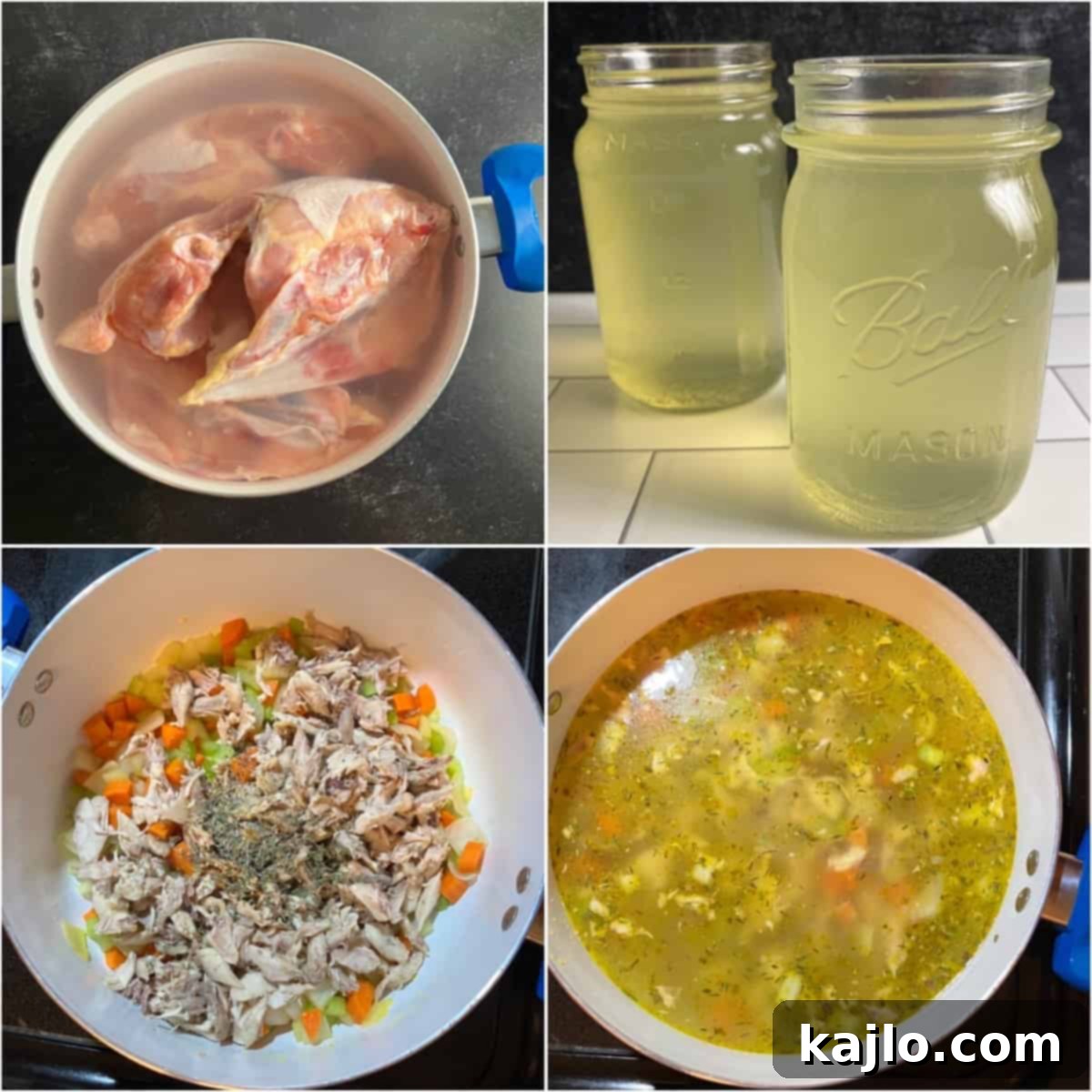
Once you have your homemade chicken back stock and cooked meat ready, making the comforting chicken back soup is a breeze. This recipe is designed for ease and flavor, making it perfect for a family dinner. The specific quantities for all ingredients can be found in the detailed recipe card section below.
Step-by-Step: Preparing Your Comforting Chicken Back Soup
- Prepare Vegetables: Begin by mincing the garlic cloves. Dice the onion, celery stalks, and carrots into small, uniform pieces. This ensures even cooking and a pleasant texture in your soup.
- Heat Oil: In a large Dutch oven or heavy-bottomed pot, heat the olive oil over medium to medium-high heat on your stovetop. Allow it to shimmer slightly.
- Sauté Aromatics: Add the minced garlic, diced onion, celery, and carrots to the heated oil. Sauté them for approximately 10 minutes, stirring occasionally, until the vegetables have softened. The goal is to soften them and release their aromatic flavors, not to brown them extensively.
- Combine Ingredients: Pour in your homemade chicken back broth. Add the dried thyme, dried oregano, and your reserved cooked chicken back meat. Season with salt and black pepper to taste. Bring the mixture to a visible simmer and let it cook for about 10-15 minutes, allowing the flavors to meld. (Chef’s Note: If your cooked chicken back meat is still warm from making the broth, add it to the soup when you introduce the pasta in the next step to prevent it from overcooking and becoming tough.)
- Add Pasta: Stir in 1 cup of dry pasta noodles. Cavatappi is a great choice as its corkscrew shape holds the broth beautifully, but feel free to use your favorite small pasta. Continue to cook for about 15 minutes, or until the pasta is al dente (tender yet firm to the bite) and the soup is simmering gently.
- Serve and Garnish: Ladle the hot chicken back soup into individual bowls. For an extra burst of freshness and brightness, add a squeeze of fresh lemon juice and a sprinkle of chopped fresh parsley just before serving. Enjoy this deeply satisfying and nutritious meal!
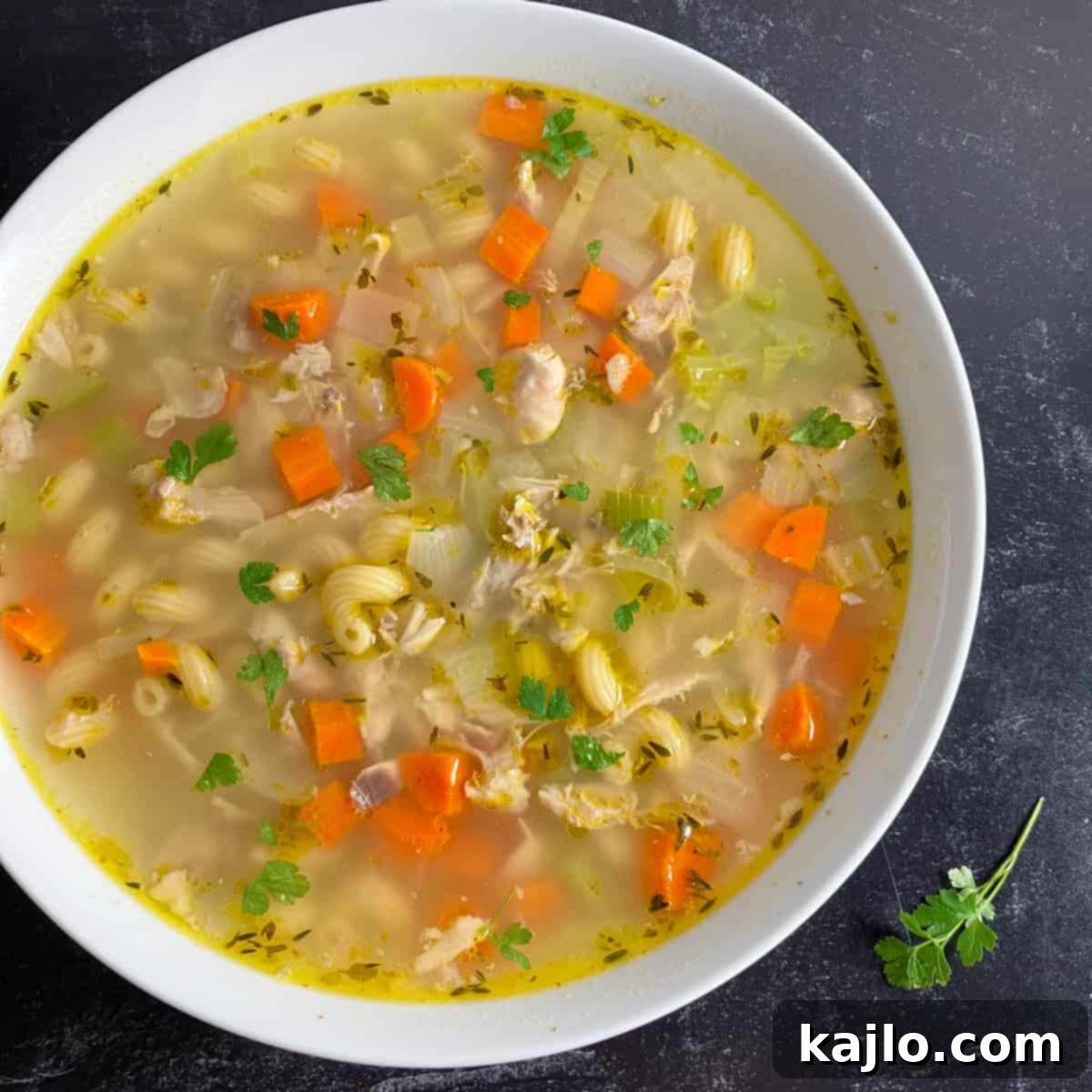
Storage and Meal Prep: Maximizing Your Chicken Back Creations
Both raw chicken backs and your finished chicken back stock and soup freeze exceptionally well, making them ideal for meal prepping and minimizing food waste. For long-term storage of raw or cooked chicken backs, place them in a vacuum-sealed freezer bag or an airtight container in the freezer. They will maintain their quality for several months.
For meal prep with chicken back soup, it’s best to store the cooked pasta separately from the soup broth. Cook the pasta al dente, drain it, and lightly toss it with a touch of olive oil to prevent sticking. Store the soup (without pasta) and the pasta in separate airtight containers in the refrigerator for up to 3-4 days. This method prevents the pasta from becoming mushy and absorbing too much broth, preserving the soup’s optimal texture.
To reheat chicken back soup, simply place your desired portion in a microwave-safe bowl and microwave on high for 1-2 minutes, or heat gently on the stovetop. Add the pre-cooked pasta to your serving bowl just before reheating, or add it to the warm soup. If the soup appears too thick or dry after storage, you can always add a splash of extra broth or water to achieve your preferred consistency.
Nutritional Powerhouse: The Benefits of Chicken Backs
Beyond their affordability and delicious flavor, chicken backs are a surprisingly nutrient-dense food. They offer a range of essential vitamins and minerals that contribute to overall health. Incorporating them into your diet, especially as a bone broth, can be a fantastic way to boost your nutritional intake.
Here’s a breakdown of the nutrition facts for a ½ raw chicken back serving, based on Cronometer data:
- Calories: 316
- Carbohydrates: 0 grams
- Fiber: 0 grams
- Fat: 28 grams
- Saturated fat: 8 grams
- Cholesterol: 78 mg
- Protein: 14 grams
- Thiamin: 3% DV
- Riboflavin: 7% DV
- Niacin: 24% DV
- Pantothenic Acid (Vitamin B5): 8% DV
- Vitamin B6: 9% DV
- Vitamin B12: 4% DV
- Folate: 2% DV
- Vitamin A: 5% DV
- Vitamin C: 3% DV
- Calcium: 1% DV
- Iron: 5% DV
- Magnesium: 4% DV
- Phosphorus: 11% DV
- Potassium: 4% DV
- Selenium: 17% DV
- Zinc: 8% DV
These values represent the meat and skin of a raw chicken back. As you can see, chicken backs are an excellent source of niacin (Vitamin B3), which is crucial for energy metabolism and DNA repair. They also provide a good source of important minerals like phosphorus, essential for bone health and energy production, and selenium, an antioxidant that supports thyroid function and immunity. For those monitoring fat intake, removing the skin before eating can significantly lower the total and saturated fat content.
Naturally, chicken backs are a keto, low-carb, and gluten-free food, making them suitable for various dietary needs. However, remember that the chicken back soup recipe, which includes pasta, will not be gluten-free. Full nutrition information for the soup can be found in the recipe card below.
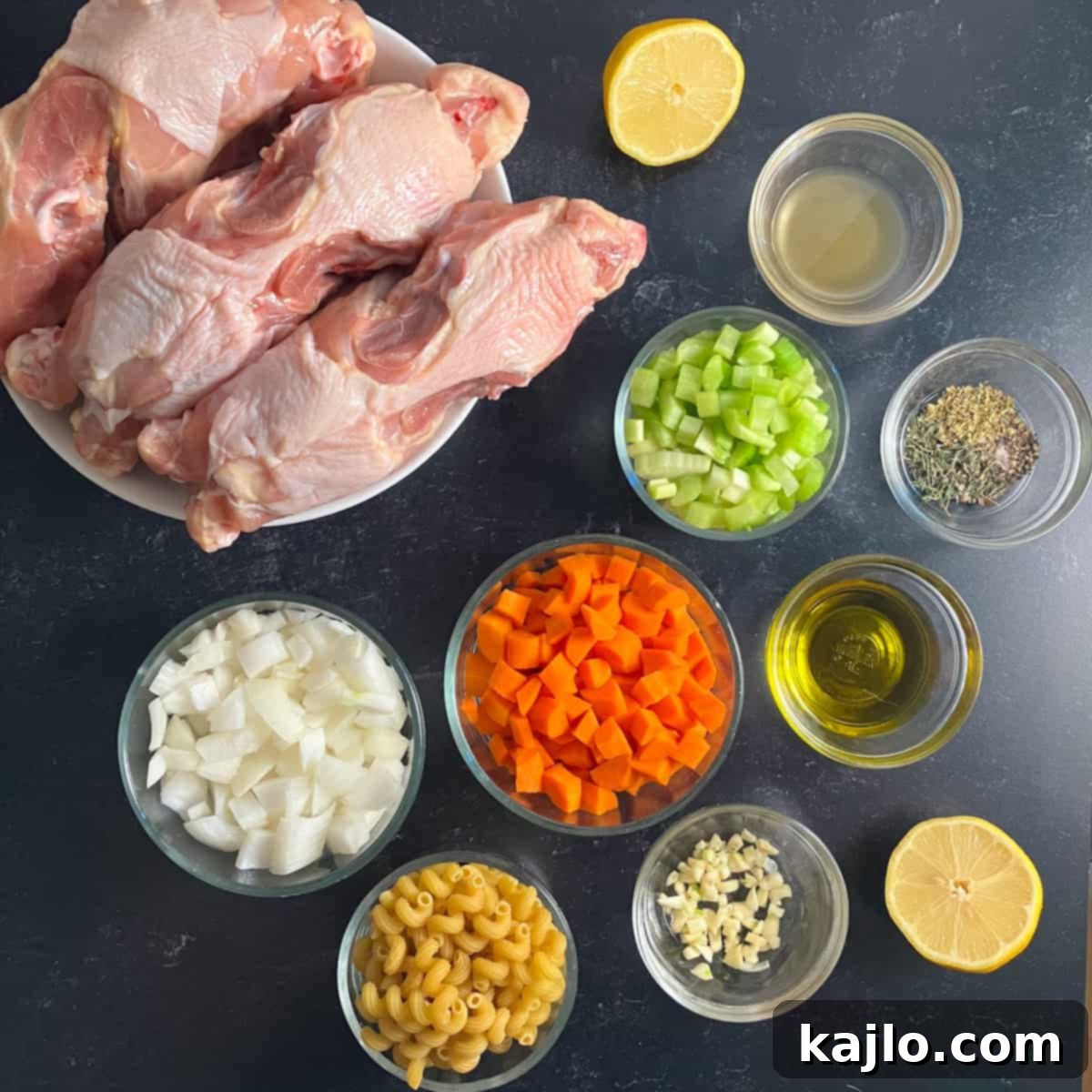
Frequently Asked Questions About Chicken Backs
Here are answers to some common questions about cooking and enjoying chicken backs:
Do Chicken Backs Contain Collagen?
Absolutely, chicken backs are a fantastic natural source of collagen! Collagen is a structural protein found abundantly in bones, skin, cartilage, and other connective tissues of chickens. When you slow-simmer chicken backs to make bone broth, you extract this valuable collagen, creating a rich, gelatinous liquid that’s known for supporting joint health, skin elasticity, and gut lining integrity. Making your own chicken back bone broth is a much more economical and natural way to get collagen compared to expensive supplements.
How to Cook Chicken Backs in the Oven?
While you could technically roast chicken backs in the oven, similar to how you’d prepare other chicken pieces, it’s generally not the most efficient or satisfying method due to their low meat content. Roasting primarily yields crispy skin and a small amount of meat, but doesn’t fully utilize the bone’s potential. For maximum value, flavor, and nutrition from your purchase, you’ll likely get more bang for your buck by transforming them into a savory chicken soup or stew, where the bones can impart their goodness into the liquid.
What Are Chicken Backs Used For Beyond Soup?
While soup and stock are stellar uses for chicken backs, their versatility extends further! For example, many cuisines have creative ways to prepare them. You could try making a flavorful Jamaican Chicken Back Stew, often referred to as brown stew chicken, which pairs wonderfully with rice. Another option is to prepare “fried chicken backs” (sometimes confusingly called “chicken ribs”) using a similar breading and frying technique as traditional fried chicken, offering a tasty and unique snack or meal component.
Are Chicken Backs a Healthy Choice?
Determining what constitutes “healthy” always depends on individual dietary needs, health goals, and personal preferences. However, from a nutritional standpoint, chicken backs are a highly nutrient-dense food. They serve as an excellent source of protein and are rich in numerous essential vitamins and minerals, notably niacin, phosphorus, and selenium. When prepared as bone broth, they also offer collagen, which provides various health benefits. As part of a balanced diet, chicken backs can be a very healthy and beneficial protein source.
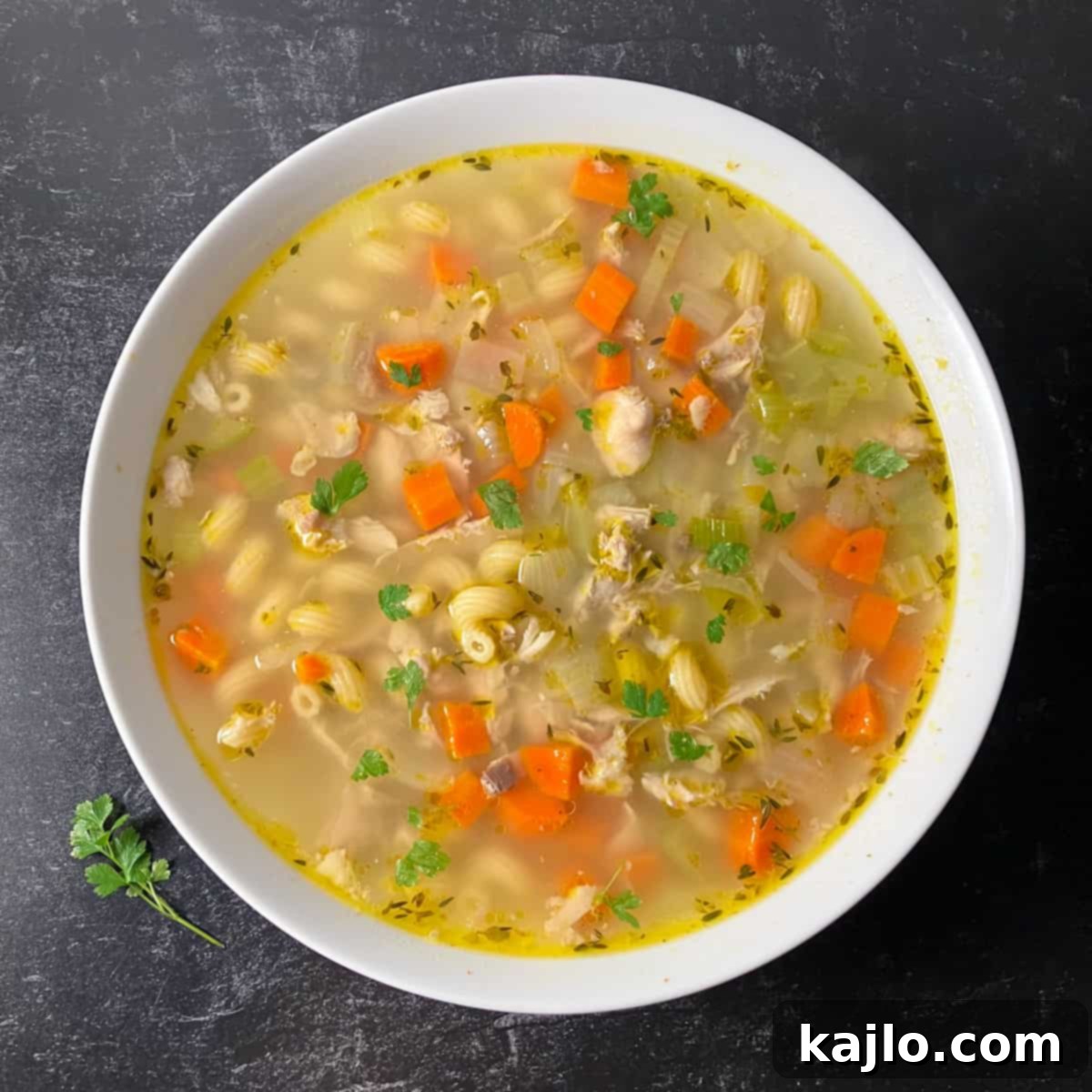
Creative Ways to Utilize Your Homemade Chicken Back Stock
Beyond making delicious soup, your homemade chicken back bone broth is an incredibly versatile ingredient. Use it as a flavorful base in a multitude of other recipes, adding depth and nutrition to countless dishes. Here are just a few ideas:
- Shrimp Chowder (New England Style)
- Instant Pot Italian Sausage Soup
- Instant Pot Lima Beans
- Lobster Ravioli Sauce Recipe
Don’t forget the tender cooked meat salvaged from your chicken backs! It’s perfect for shredding and incorporating into tacos, casseroles, BBQ sandwiches, savory rice dishes, or any other recipe where you would typically use cooked chicken.

Chicken Back Recipes (Chicken Backs for Stock and Soup)
Summer Yule
Print Recipe
Pin Recipe
Ingredients
For Chicken Back Stock:
- 2¾ lbs. chicken backs 1.25 kg (about 3 chicken backs)
- 1 tablespoon apple cider vinegar
- 12 cups water (plus more as needed)
For Chicken Back Soup:
- 2 tablespoons olive oil
- 3 cloves garlic
- 1 medium onion
- 3 ribs celery
- 3 medium carrots
- 1 teaspoon dried thyme
- ½ teaspoon dried oregano
- 7 cups chicken back stock
- 2 cups cooked chicken back meat (or whatever you yield from the stock recipe)
- salt and pepper, to taste
- 1 cup dry pasta noodles
- lemon wedges and chopped fresh parsley (optional garnish)
Instructions
To make chicken back stock recipe:
- Place the raw chicken backs, cider vinegar, and water in a big pot. The chicken backs should be covered by water. Add more water if needed.
- Simmer the chicken backs on the stovetop on low or medium-low for 2-3 hours. Skim any scum that forms on the top of the stock. Partially cover the pot and turn down the heat if too much water is evaporating.
- Strain the hot broth through a colander. For a nice clear broth, strain it through cheesecloth over the colander.
- Remove the chicken back meat from the skin and bones. Chop it and set it aside in the fridge to use in the soup recipe below. My chicken backs only yielded about 2 cups of meat total.
- Note: You need 7 cups of broth to make the soup, so ensure you don’t boil off too much water.
To make chicken back soup recipe:
- Mince the garlic, and dice the onion, celery, and carrots.
- Heat olive oil in a Dutch oven over medium to medium-high heat on the stovetop.
- Place the garlic, onion, celery, and carrots in the pot, and soften over the heat for 10 minutes. You’re not looking to brown them.
- Add the thyme, oregano, chicken back broth, chicken back meat, salt, and pepper. Cook until it comes to a visible simmer (about 10-15 minutes). (Note: if the meat is still warm from making the broth, add it when you add the pasta instead.)
- Add 1 cup of dry pasta noodles (I recommend cavatappi) to the soup. Cook until the pasta is al dente and the soup is simmering, about 15 minutes.
- Ladle into bowls. Add a squeeze of fresh lemon juice, a sprinkle of fresh parsley, and serve.
Equipment
- Cast Iron Dutch Oven
- Colander
- Knife
Notes
💭 Expert Tips from Dietitian Summer Yule
This is a level 1 recipe (may help support fat loss). Chicken back soup is the ultimate in comfort food, and it has elements that make it great for weight loss too. In general, broth-based soups are a good choice when you want to lose weight or maintain a healthy weight.
First off, you get a BIG serving of food for a bit over 500 calories. It’s a hearty meal that will nourish you and help keep you full. You must maintain a calorie deficit to lose weight, and foods that help you feel full on fewer calories may help.
Three important elements to make meals more satisfying are protein, fiber, and fluid volume. Chicken back soup has all three. You get lean protein from the white meat chicken, fiber and fluid from veggies, and more fluid from the broth.
Use whole grain noodles in your soup to help bump the fiber up even more. (Brown rice or wild rice won’t work here because they have a much longer cooking time.)
This soup is great to take in a thermos for lunch, and it’s much lower in sodium than many canned soups. Plus, the simple ingredients tend to appeal to even picky eaters. It’s really a win all around!
Hot tip! For the most accurate nutrition info, divide the entire recipe between 3 serving bowls or containers. There can be significant variation in volume measurement (i.e., measuring the soup cup by cup). This can leave you under or over the expected number of servings.
Nutrition information is for one serving.
Nutrition
Carbohydrates: 43.3g
Protein: 33g
Fat: 30g
Saturated Fat: 7.6g
Potassium: 424.7mg
Fiber: 5g
Vitamin C: 22.1% DV
Calcium: 9.8% DV
Iron: 18% DV
Nutrition Info Disclaimer
All recipes on this website may or may not be appropriate for you, depending on your medical needs and personal preferences. Consult with a registered dietitian or your physician if you need help determining the dietary pattern that may be best for you.
The nutrition information is an estimate provided as a courtesy. It will differ depending on the specific brands and ingredients that you use. Calorie information on food labels may be inaccurate, so please don’t sweat the numbers too much.
“To taste” means to your preferences, which may have to be visual to follow food safety rules. Please don’t eat undercooked food x
Join our community! Subscribe for all of the latest and greatest recipes, and follow me on Facebook, Pinterest, Instagram, and YouTube!

